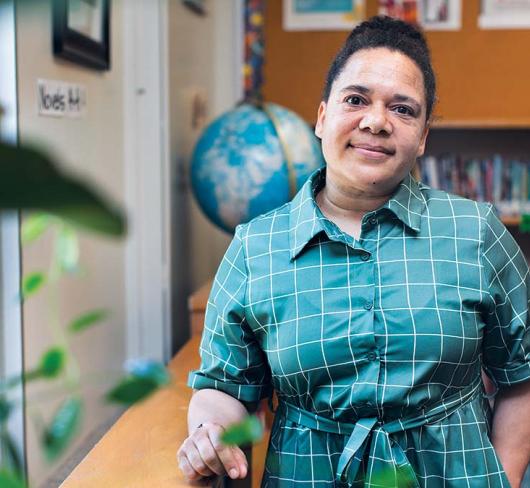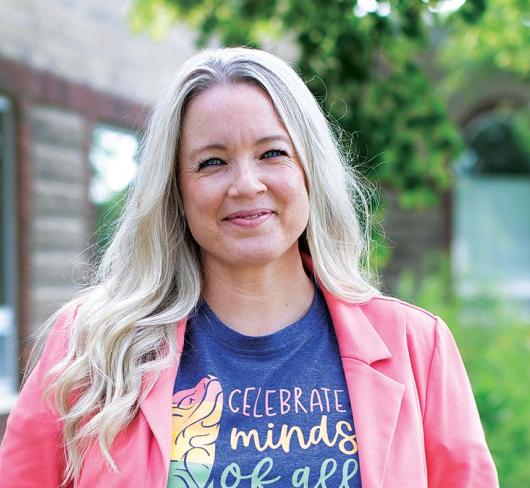
A Call to Action
All children deserve an education that recognizes their diverse needs and abilities, but as another school year unfolds in Ontario, teachers find themselves facing increasingly complex and diverse student needs without adequate resources and supports.
Managing curriculum demands while providing a safe and supportive learning space that allows all students to succeed has become a monumental task that demands immense dedication, creativity and resilience from educators. The challenge of meeting student needs is compounded by staffing shortages, long wait times for assessments and an inadequate government funding formula, leaving teachers to face increasing workloads without sufficient support.
The Landscape of Special Education in Northern Ontario
Special education is an area that impacts us all but has an even greater impact in Ontario’s most northern boards. Teaching in a northern board presents a unique set of challenges and rewards. The region is marked by stunning contrasts, from the breathtaking beauty of starry nights and the captivating northern lights to the harsh realities of extreme cold, often dipping below -400 C. Our landscapes are filled with rocks, lakes and trees, creating an environment of solitude where students often ride the bus for an hour without encountering another soul.
I have been fortunate to learn and teach in the Rainy River school board for the last 24 years. During that time, I have worked with dynamic educators across a region that boasts vibrant and tightly knit school communities. I currently work out of Fort Frances, our region’s largest city with a population of just over 8,000 people and a K-6 school that serves 260 students. As a classroom teacher, literacy consultant, special education teacher, and from my current position in Kindergarten, I have seen the impact of education in northern Ontario across generations of our families and their communities.
While the area is abundant in many ways, challenges extend beyond the natural landscape. Teachers are tasked with accommodating students with a wide range of special needs, from learning disabilities and autism spectrum disorder to emotional and behavioural challenges. But many schools are not equipped to support the children with disabilities who are fully or partially integrated into their classrooms. In northern boards, the reality is three-grade splits in a class with special education support that may be shared between school sites that are an hour apart.
Here, the absence of one staff member or addition of one or two new students in a small school can quickly shift the dynamics of a classroom. Several schools face significant staffing shortages on a daily basis, while permanent job postings at the most remote school sites often have no applicants. Daily fail-to-fills cause classroom teachers to shift quickly to Plan B when intervention support is pulled while the special education resource teacher (SERT) covers French as a Second Language classes or when the educational assistant (EA) support has been reassigned to assist a student in another room. The ripple effects of daily disruptions are felt by all.
Research shows that when implemented well, inclusive education is the best option for most students with special education needs. But without proper funding and staffing, the practical application of inclusive education is often at odds with current structures of our schools, leaving many educators feeling overwhelmed and many students underserved. The impact of our northern geography and the significant limitations in human resources simply have not been accounted for in the current government’s budget lines.
Staffing Shortages: A Critical Barrier Across the Province
As schools struggle to meet current student needs, statistics show the number of learners in Ontario who are identified as having special education needs is continuing to rise. In 2012-13, the number of students in Ontario receiving special education programs or services was 331,532, or 16.3 per cent. By 2021-22, this number had increased to 352,672 (17.4 per cent).
The 2023-24 results of People for Education’s annual survey show that 94 per cent of elementary schools have a special education teacher, either full or part-time, a decrease from 100 per cent in 2019-20. A flawed funding model, combined with challenges in recruiting and retaining specialist teachers and support personnel, is significantly impacting our education system, with nearly half of elementary schools reporting shortages of educational assistants every day.
Staffing shortages lead to disruptions in student programming as SERTs are moved to cover for classroom teachers and EAs, which disrupts their regular programming, while paperwork and other duties pile up until they can be attended to. Intervention groups are stopped and classroom teachers find themselves juggling lesson plans to try and fill the gaps while maintaining daily routines and covering several curriculum levels.
Additionally, a lack of funding has reduced professional development and collaboration opportunities, further impacting staff who are already stretched thin. Educators who once worked with dedicated specialist teachers and central support staff now find themselves navigating the complexities of increasingly diverse learners alone. The absence of ongoing professional learning leads to higher workloads as colleagues are left to meet on the fly during breaks and after school or teachers find themselves purchasing professional reading materials to study after hours as they attempt to fill student learning needs on their own.
Long Wait Times for Assessment and Professional Support
Another critical issue is the long wait times for student assessment and access to professionals. Across the province, regular access to psychologists is at an all-time low, with only 45 per cent of schools in more populous areas reporting access. That number falls to just four per cent for northern schools. This means students wait anywhere from several months to several years for a comprehensive assessment from licensed professionals.
Access to speech language pathologists and occupational therapists also involves a lengthy wait. These delays hinder early intervention efforts, leaving students without the necessary supports to thrive both socially and academically. Teachers are left in limbo, which can lead to frustration for educators and their students. Without clear guidance, many teachers find themselves searching for manageable ways to incorporate fine-motor, self-regulation and language-development strategies into their already packed classroom planning.
The Funding Failure
As classrooms become increasingly complex, the government continues to rely on a simple funding formula that cannot keep pace with Ontario’s diverse student population. This generalized approach to specialized circumstances has an even greater impact on northern boards. A new tool on ETFO’s Building Better Schools website (BuildingBetterSchools.ca) lets you search how much funding has been cut from your local public schools since 2018 (adjusted for inflation). With cuts amounting to more than $1,500 per student, my small school alone received over $343,000 less in funding this year. The current funding model is not meeting the needs of any school in Ontario, and certainly does not account for the unique challenges faced by remote and rural communities, leaving school boards struggling to allocate resources effectively.
The Ripple Effect: Impact on Educators and Students
The cumulative effect of these challenges is a significant increase in workload for teachers. Educators are putting in more hours creating resources, filling out paperwork advocating for student support, and implementing strategies to support behaviour and student mental health. This increased workload can lead to burnout and job dissatisfaction, leaving many teachers feeling they are unable to provide the level of support their students require.
In northern Ontario, assessment waitlists are long, and referrals must be prioritized based on factors such as age and student needs. Accessing professional supports like occupational and speech therapy often occur in six-week cycles to help balance caseloads with sharing access equitably. More often than not, student crises don’t align with support schedules, leaving teachers and support staff who are the daily front-line workers for these children to search for resources and research strategies to modify and accommodate curriculum to ensure students succeed.
The impact on students is equally concerning. When funding dollars and teaching staff are spread too thin, the quality of education suffers. Students with special needs may not receive the attention and support they deserve, leading to disengagement and lower academic success. When a broad range of placement options that are responsive to students’ needs are not available, “inclusion” merely becomes a student’s geographic location in a school, such as a regular classroom.
With small school populations sharing a dwindling pool of specialized supports, schools are forced to work creatively with very limited options to meet their students’ needs. In the north, this can mean the most remote schools share a special education teacher between school sites. Outlying schools with the neediest populations often have the most difficult time accessing outside resources such as extra intervention support. The lack of proper support can exacerbate behavioural issues, creating a cycle of frustration that impacts everyone in the classroom.
A Call for Action: Addressing the Crisis
To address escalating challenges, it is imperative that education stakeholders work together to take a proactive approach.
1. Increasing funding
The government must recognize the unique needs of Ontario classrooms and particularly complex factors faced in the province’s north and allocate resources accordingly. Increased funding would allow school boards to hire more specialized staff, provide individualized layers of support and invest in necessary resources that fit their students’ needs.
2. Address assessment wait times
Streamline assessment processes to reduce wait times for students. This could involve increasing the number of professionals available for assessment and/or looking for ways to build partnerships with local health services to ensure students receive timely evaluations.
3. Enhance support for teachers
Funding meaningful, timely and responsive professional development opportunities that are tailored to the needs of teachers working with students with special needs is essential. Provide educators with the time, tools and training they are seeking to reduce workloads and enhance student outcomes.
4. Ongoing advocacy and awareness
Raising awareness about the challenges faced in Ontario classrooms is vital. Educators, parents and community members must advocate for proper supports for students with special education needs. Our collective voices can drive change at the provincial level, ensuring that issues affecting all schools, especially those in the north, are addressed.
The increasing demands of special education in Ontario classrooms, particularly in its northern boards, underscore a pressing need for systemic change. Every child deserves a quality education tailored to their unique needs, yet the realities of insufficient funding, staffing shortages and geographic disparities pose significant barriers. As educators strive to provide inclusive learning environments, we require rich layers of support that can flex and move as quickly as our classroom landscapes do.
The call to action is clear: we must advocate for policies that not only recognize the diverse needs of students but also allocate adequate resources to meet them. By prioritizing funding and access to professional supports and resources, we can work together to create an educational landscape where all students, regardless of their challenges, can thrive.
Cristol Bailey is a member of the Rainy River Teacher Local.

